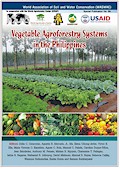| Book Chapter |
 |
|
| Title | Selection of Vegetable Crops under Vegetable-Agroforestry System | | Author | Manuel C. Palada, D. L. Wu, G.C. Luther, Ma. Elena Chiong-Javier, M. Bhattarai, Agustin Mercado, Jr., M Reyes and Caroline Duque-Piñon | | Editors | Delia Catacutan, Agustin Mercado, Jr., Ma. Elena Chiong-Javier, Victor B. Ella, Victoria O.Espaldon, Agnes C. Rola, Manuel C. Palada, Caroline Duque-Piñon, Jean A. Saludadez, Anthony M. Penaso, Miriam R. Nguyen, Charmaine Pailagao, Isidra B. Bagares, Nathaniel R. Alibuyog, David Midmore, Manuel Reyes, Rebecca Cajilig, Wanraya Suthumchai, Karika Kunta and Samran Sombatpanit | | Year | 2012 | | Book Title | Vegetable-Agroforestry Systems in the Philippines | | Publisher | World Association of Soil and Water Conservation (WASWAC), Beijing, China and the World Agroforestry Center (ICRAF), Nairobi, Kenya | | City of Publication | Beijing, China | | Volume | Special Publication No. 6b | | Number of Pages of the book | 18 | | Pages | 113-130 | | Call Number | BC0324-12 | | Keywords | Alley cropping, tree-crop interaction, tropical fruit trees, vegetable crops |
|
| Abstract: |
| Tree-crop interactions in agroforestry systems involving vegetable
crops have not been studied extensively because previous research in agroforestry focused on agronomic arable field crops. A vegetable-agroforestry system was established at AVRDC - The World Vegetable Center to: 1) study
tree-crop interactions in alley-cropping vegetable crops with tropical fruit
trees in terms of competition and/or complementarity: 2) investigate the influence of tree crops on natural habitat and insect pest populations in vegetable
alley-cropping systems; and 3) evaluate total productivity and economic re-
turns from high value horticultural crops in an agroforestry system. Seedlings
of 12 tropical fruit tree species: Anona reticulata, Artocarpus heterophyllus, Chrysophyllum caimito, Coffea arabica, Eugenia brasiliensis, Eugenia
uniflora, Pouteria caimito, Pouteria caampechiana, Psvdium littorale, Rollinia
mucosa, Svzygium samarangense, and Tamarindus indica were established in
December 2005 at AVRDC's Organic Vegetable Research Plots. Vegetable
crops were grown sequentially in alley beds between tree hedgerows 10
months after tree establishment. Monoculture cropping of vegetables was established for comparison. The trial was conducted using a randomized complete block (RCB) design with four replications. Establishment and initial
growth of trees varied according to species. Outstanding species for stand establishment and growth were A. heterophyllus, C. caimito, T. Indicus and A.
reticulata. Marketable yields of vegetables varied with species over a period
of 3 years and 4 sequential cropping seasons. During the first two seasons,
marketable yield levels were not influenced by tree hedgerows, which were in
the stage of being established. The effect of tree-crop competition in reducing
yield was not apparent. As fruit trees became fully established and developed
full canopies, the demand for soil moisture, nutrients and light increased, which resulted in significant yield reduction for sweett pepper (64%), tomato
(47%), and Chinese cabbage (20%). Cucumber and eggplant were less affected by tree hedgerows, with yield reductions of I% and 11 %, respectively.
Shading of vegetables by trees was considered a major factor in decreased
yield. With time, yield loss from vegetable crops will be compensated by
yield gains in fruit trees as some species were already at the reproductive
stage. Incidence of insect pests and economic returns from vegetable production under hedgerow intercropping are presented in the report. Our results
suggest that integration of high value vegetable crops during the early stage
of tree establishment in agroforestry systems can provide quick economic returns which are of tremendous benefits to livelihoods of smallholder growers
as the returns from trees can be obtained later. The early economic return
from vegetables compliments the benefits from fruits leading to sustainable
vegetable-agroforestry systems which will provide positive incentives for the
resource-poor and smallholders in the tropics. |
|